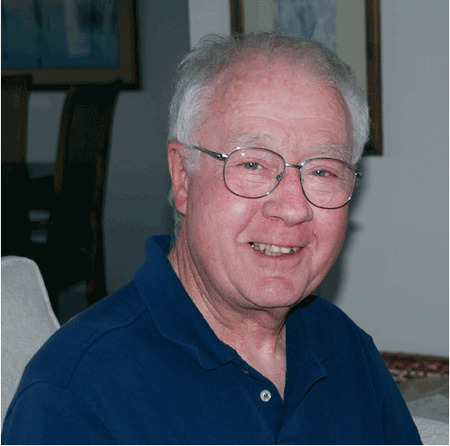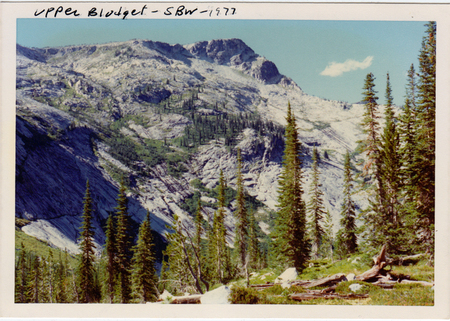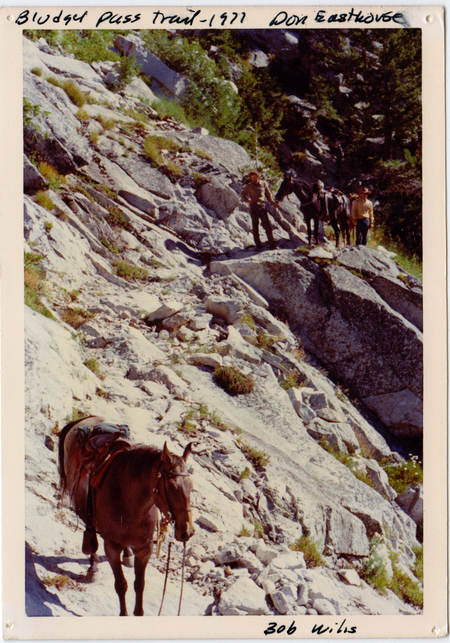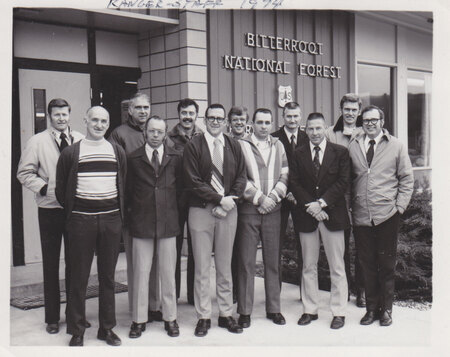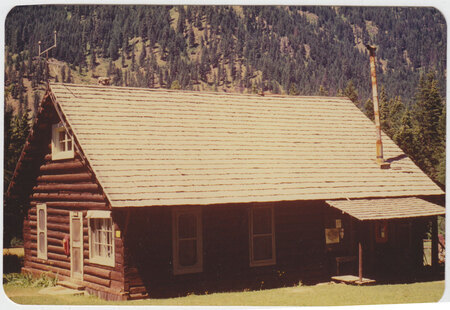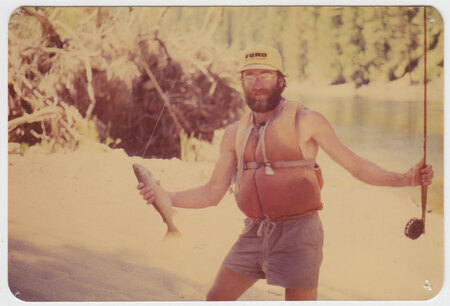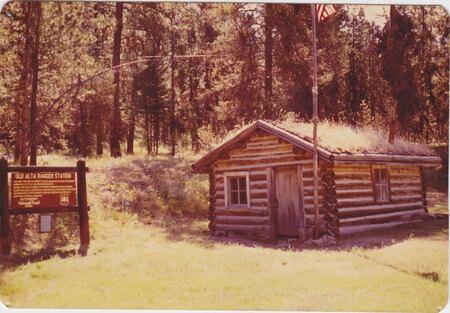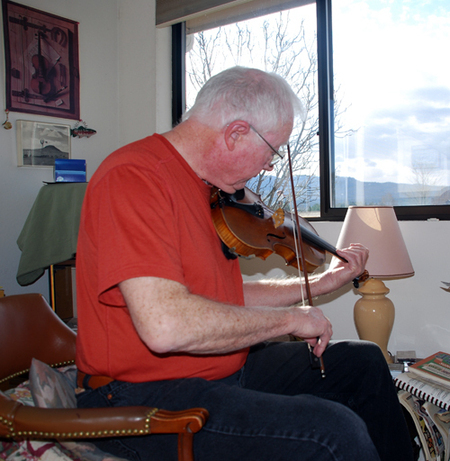Episode 7 : Appreciating and Protecting the Resource That Is Wilderness : an interview with Ed Bloedel [Implementation of the Wilderness Act of 1964] Item Info
In this episode, titled “Appreciating and Protecting the Resource That Is Wilderness,” we hear from Ed Bloedel, who was instrumental in helping to write the first management plans for the Selway-Bitterroot Wilderness, thus implementing the Wilderness Act of 1964 in a tangible, practical way.
Ed holds a degree from the University of Montana in Range Management Forestry, and started out as a forester in the Beaverhead Forest in southwestern Montana; from there he worked as District Ranger on both the Custer and the Gallatin Forests in Montana. His work with the Regional Wilderness Staff in writing Wilderness Act Guidelines then led him to the Bitterroot Forest as Wilderness Staff Officer. He was later promoted to Regional Wilderness and Wild River Staff Officer in the Southern Region, Atlanta, Georgia, where he led numerous Wilderness, Wild River, and Trail Training sessions. He eventually served as the Director of Wilderness for the entire United States, based in Washington DC, where he spread the Wilderness Act’s Philosophy of wilderness as a natural resource to areas all over the country.
Because of his experience as a smoke jumper, a river runner, and his knowledge of recreational and resource management, Ed joined and led teams in crafting the first wilderness management plans for wild river use, natural fire use and wilderness resource management in the Selway-Bitterroot that set the standard for wilderness management all over the United States. Today, Ed is still active in helping to raise awareness of wilderness issues, and write bills that further wilderness preservation. Ed lives on the edge of the Bitterroot Mountains where he plays his fiddle in the style of the original settlers who called the Selway-Bitterroot home.
Episode 7 : Appreciating and Protecting the Resource That Is Wilderness : an interview with Ed Bloedel [Implementation of the Wilderness Act of 1964] [transcript]
00:00:00:00 - 00:00:29:08 Debbie Lee: Welcome to the Subway Bitterroot Wilderness History Project, which is made possible by a grant from the National Endowment for the Humanities. The University of Idaho, and Washington State University. Part of the project’s mission is to collect, preserve, and make public oral histories documenting the history and people of the subway. Bitterroot wilderness. For more information, please visit our website at SPW lib argue Idaho redo.
00:00:29:11 - 00:00:54:08 Debbie Lee: And then I think people, I think people get so much out of being in a wilderness setting once you take away cars and money and telephones, people are different and they are different to each other, I think. And, and, and then they draw on things in themselves that maybe are a little rusty from our crazy life out here.
00:00:54:08 - 00:01:25:08 Debbie Lee: Now, I think the ways that people get along when they’re isolated in a place like that, that they place that they want to be familiar, is a wonderful thing.
00:01:25:10 - 00:01:58:07 Debbie Lee: Thank you for joining us on the seventh episode of the South Bitterroot Wilderness History Project. In this episode, titled Appreciate Eating and Protecting the Resource that is wilderness, we hear from Ed Blade, who is instrumental in helping to write the first management plans for the Selway Bitterroot Wilderness. Thus implementing the Wilderness Act of 1964. In a tangible, practical way, Ed holds a degree from the University of Montana in range Management forestry and started out as a forester in the Beaverhead Forest in southwestern Montana.
00:01:58:09 - 00:02:23:18 Debbie Lee: From there, he worked as district ranger on both the Custer and the Gallatin forests in Montana. His work with the Regional Wilderness Staff in writing Wilderness Act guidelines then led him to the Bitterroot Forest as Wilderness Staff Officer. He was later promoted to Regional Wilderness and Wild River Staff Officer in the Southern Region, Atlanta, Georgia, where he led numerous wilderness, wild river, and trail training sessions.
00:02:23:20 - 00:02:57:13 Debbie Lee: He eventually served as the director of Wilderness for the entire United States, based in Washington, DC, where he spread the Wilderness Act’s philosophy of wilderness as a natural resource to areas all over the country. Because of his experience as a smokejumper, a river runner, and his knowledge of recreational and resource management. Ed joined and led teams in crafting the first wilderness management plans for wild river use, natural fire use, and wilderness resource management in the Selway Bitterroot that set the standard for wilderness management all over the United States.
00:02:57:15 - 00:03:16:01 Debbie Lee: Today, it is still active in helping to raise awareness of wilderness issues and write bills that further wilderness preservation. Ed lives on the edge of the Bitterroot Mountains, where he plays his fiddle in the style of the original settlers, who called the Solway Bitterroot Home.
00:03:16:04 - 00:03:37:19 Ed Bloedel: the wilderness had been established for a long time, but he never really had a specific plan. How how we’re going to try to manage it. It was after region one workshop that told us, we sat together and worked, instructed by Bill Warf as the recreation staff officer and others, what wilderness was like and what it was about.
00:03:37:19 - 00:03:59:18 Ed Bloedel: And, then our studies and we said, well, it’s time we put together a plan for this. There were there was overuse up around Big Creek Lake, up around, the most popular lakes back in here on the west side coming out of Hamilton. So it was time to figure out what to do. So we began to prepare, plan.
00:03:59:18 - 00:04:24:27 Ed Bloedel: And in those days, we thought it’d be a good idea if we involved people because there were a lot of people interested in. So a bit of Wilderness Outfitters besides them, a lot of individuals that live here in the Valley or that come from all over Montana just to work their way back in their. So we had a list of, I don’t know, two, 300 different people.
00:04:25:04 - 00:05:12:07 Ed Bloedel: And and agencies and all the county officers and the state officers and even the congressional delegation. Mac Baucus was on board then, too. He was kind of a young senator then. That was in 1975, 74 and 75. And we were working on that. And he’s still a senator. so we, we we started to write the plan and we’d get by gathering the people together and telling them what some of the problems were and what the situation was and how, and then asking, how do you think we should manage this area and still keep it as wild as possible?
00:05:12:09 - 00:05:30:12 Ed Bloedel: And so we set up a little table and had group discussion, and then they’d bring back their report. And then we put those reports together and we had help of course, with a coordinating people and know how to do that sort of thing. And then we prepared the plan and finally put it in place.
00:05:30:15 - 00:05:38:24 Debbie Lee: So do you remember any specific struggles or controversies or. moments that happened during that process?
00:05:38:27 - 00:06:04:19 Ed Bloedel: Yeah. Let me give you a specific two ladies, two of my favorite ladies here. I think they may have passed down. Bitterroot wrote me a letter one time during the process of who it was, maybe just after or just before I can remember. We made main plan and said they were walking up, Sawtooth Creek and, and the log was gone.
00:06:04:21 - 00:06:26:19 Ed Bloedel: They normally cross, so they had to cross the stream and early in the spring and they didn’t make it. They fell down and they got wet. They wrote me a it’s hilarious little story about how in the wilderness, couldn’t you at least replace a log, you know, on the bridge they wrote, I wrote it to the Forest Service.
00:06:26:19 - 00:06:58:20 Ed Bloedel: And of course, the 50 Wheeler staff officer gets the answer for the forest supervisor. Write a letter back. So I wrote him one back and told him how wonderful a wilderness experience they had it and, I don’t think we will be replacing that bridge. It should stay wild. we had a good conversation after that. They would eventually we’d put another log across their single log bridge, because in springtime, the water is so swift, it’s very difficult to get across.
00:06:58:22 - 00:07:23:01 Debbie Lee: That’s a great story. So that must have involved a lot of different people’s idea about what wilderness was, especially so soon after the Wilderness Act was passed. Oh, how did you navigate that? And what what has your own definition of wilderness, you know, changed through that process and through the years?
00:07:23:02 - 00:08:02:09 Ed Bloedel: It never changed, substantive, stronger over through the years. You see, my career after here, I went to the region eight, and I was the wilderness and trails river specialist there for that whole region, South east region. And then I went from there into Washington office as the wilderness specialist for the chief. And in those days, we I began to before I went there, though, I had the philosophy of what it’s about based on the law by taking the law itself, where it says specifically, this is what wilderness is.
00:08:02:09 - 00:08:55:11 Ed Bloedel: It’s defined. It starts right out in the first, right under the preamble in order to, in order in order to, prevent all this development and everything being developed where Congress established an enduring resource of wilderness and the word and right from there, an enduring resource of wilderness set up the philosophy. Philosophy is that wilderness is a resource in itself, that it and it’s defined by the, the, the parts of the wilderness Act that say, there will be no buildings, no roads, no, for the least amount of, of, civilization as possible, natural conditions will continue to take place.
00:08:55:14 - 00:09:23:07 Ed Bloedel: And, other things can take place in wilderness like recreation, use fishing and hunting. And, but the primary purpose is to preserve the wilderness as a resource. And it stays wild always. So that philosophy was, was was crammed was which was jammed into me from Bill Wharf and some others that were leaders in region one at the time.
00:09:23:09 - 00:09:51:18 Ed Bloedel: Region one put together the first workshop for all of the affected. In fact, I have to back up a little bit here. I got that philosophy earlier than before I started working here at the Cellar bitter with. I was a ranger at the time. We developed this philosophy in region one over, and on the, Gallatin on the Gallatin Ranger District.
00:09:51:19 - 00:10:37:09 Ed Bloedel: There’s it’s it’s now combined in the two Ranger district. But at that time, it was called Squaw Creek Ranger District. And, the cit this the, Spanish Peaks Wilderness was on our district, and we had a workshop here in when I was there. And, I was there in, 1966 to 1972, sometime during that period is when we when the region had their first workshop and how to manage wilderness and put together this philosophy as to how to be in making it a basic resource and a wild resource and keeping it that way.
00:10:37:12 - 00:11:09:22 Ed Bloedel: So I was all worked up with that to them. By the time I got the job over here, I had gone through a range job and the regional office, and then a job out here. in fact, we had, when I was there at that in that Ranger district of all the Rangers in region one that had wilderness and all the resources, systems that had water in us, and a lot of the wilderness rangers that were operating, if we’re operating at a we’re still working during those period of time.
00:11:09:22 - 00:11:18:16 Ed Bloedel: We had that spring workshop, like Dick Walker and others that have been a long time with us.
00:11:18:18 - 00:11:42:27 Ed Bloedel: And that’s where I developed the the philosophy and strength and the understanding of the wilderness resource. And it’s all based on the act, and it’s based on a strict interpretation of the act. Instead of, looking in the act for where the exceptions are and what you might get away with, how you could manage it, you look for how you can keep it as wild as possible.
00:11:42:29 - 00:12:11:22 Ed Bloedel: when you have that philosophy, as there’s no problem in working with some of the exceptions if you have to. But, the philosophy, the basic philosophy is the protection of the wilderness research and keeping an intact. So I had that. And so I brought that over here when I came and, and started to say it at about that time, we were also having we had 15 or 18.
00:12:11:22 - 00:12:58:05 Ed Bloedel: I guess, new outfitter applications to float the wild. So we’re. And, so we sat down with the Moose Creek Historic Ranger in the super, but, the the recreation staff officer over there on the Nash Pierce because the rivers both on the Bitterroot Forest and on the Nez Pierce. And we sat down, a guy said, well, we gotta do something about this of course, by that time, I’d floated the river a couple times and understood how wild and it was and, the ranger Dean burn at the West Fork and myself and and, these resource systems, he said, you know, all of these guys are applying, but they’re not here yet.
00:12:58:08 - 00:13:25:14 Ed Bloedel: There’s four of them that are here. Now, let’s finish it. Let’s leave it at for let’s start with that, and let’s allow the public to start building their own use without having to come through it. Outfitter. So we set for we established in that plan the four outfitters and their for I think it was four launches apiece throughout this very short season.
00:13:25:14 - 00:13:49:02 Ed Bloedel: Then they sell way better at wilderness in the cell white River and and in the rest of the days, which was a majority of them to be open for drawing to, to be to float the river wellhead massive amount of applications for the drawing even right from the start. That’s all. You know, the philosophy and outfitting.
00:13:49:02 - 00:14:20:04 Ed Bloedel: Guiding is outfitting and guides are there to help people be able to use wilderness or enjoy the wilderness or enjoy, some other countryside hunting, but. Or, when, when there’s not enough people, you’re already getting there or, or when, when it’s too difficult for them. Long distances or too much equipment. You can’t afford all the equipment and all that sort of thing.
00:14:20:06 - 00:14:44:07 Ed Bloedel: Well, well, there was plenty of people that could afford the equipment and wanted to float the river, so we thought that we’d have a river the longest. There was a river there with all those other people, thousands of people floating along as it was the river, in the National Park Service, with motorboats floating down through the Grand Canyon, where we talked to those people.
00:14:44:07 - 00:15:05:06 Ed Bloedel: We’d talk to the different people in our writing plan and, the difficulty they were having and trying to reduce the amount of use and, and noise with the motor boats and other stuff in their wilderness in the Grand Canyon. Why not create a, a wilderness river that’s really a wilderness river. And we’ll just have one on today.
00:15:05:09 - 00:15:24:00 Ed Bloedel: Let the people camp wherever they want, let them stay as long as they want, but not let it get crowded. And that was our philosophy. And that’s why we wrote that plan as strictly as we did. And.
00:15:24:03 - 00:15:31:00 Ed Bloedel: I.
00:15:31:03 - 00:15:35:28 Ed Bloedel: Didn’t have any.
00:15:36:00 - 00:15:50:00 Ed Bloedel: Habit of. Any.
00:15:50:02 - 00:16:01:06 Ed Bloedel: Including leaving the day.
00:16:01:08 - 00:16:23:12 Ed Bloedel: The. Back and.
00:16:23:15 - 00:16:30:18 Ed Bloedel: The Redwing. These old timey yells and so on.
00:16:30:21 - 00:16:55:00 Debbie Lee: Thank you for joining us for this episode of the Selway Bitterroot Wilderness History Project, which has been made possible by the National Endowment for the Humanities. The University of Idaho, and Washington State University. The project coordinator is Debbie Lee, recorded and produced by Aaron Jepson.
Gallery
- Title:
- Episode 7 : Appreciating and Protecting the Resource That Is Wilderness : an interview with Ed Bloedel [Implementation of the Wilderness Act of 1964]
- Creator:
- Debbie Lee; Ed Bloedel
- Date Created (ISO Standard):
- 2011-04-18
- Description:
- Interview with: Ed Bloedel | Interviewers: Debbie Lee | Location: Corvallis, Montana (right outside of Hamilton) | Date: April 18, 2011 | TOPIC: Implementation of the Wilderness Act of 1964 | In this episode, titled 'Appreciating and Protecting the Resource That Is Wilderness,' we hear from Ed Bloedel, who was instrumental in helping to write the first management plans for the Selway-Bitterroot Wilderness, thus implementing the Wilderness Act of 1964 in a tangible, practical way.
- Subjects:
- podcasts conservation wilderness act regional forester 1964 wilderness act
- Section:
- Wilderness Voices
- Location:
- Selway-Bitterroot Wilderness (Idaho and Mont.)
- Publisher:
- Wilderness Voices, The Selway-Bitteroot Wilderness History Project, https://selwaybitterrootproject.wordpress.com/
- Original URL:
- https://selwaybitterrootproject.wordpress.com/2011/06/01/appreciating-and-protecting-the-resource-that-is-wilderness/
- Source Identifier:
- Selway-Podcast-ep7
- Type:
- Sound
- Format:
- audio/mp3
- Language:
- eng
- Preferred Citation:
- "Episode 7 : Appreciating and Protecting the Resource That Is Wilderness : an interview with Ed Bloedel [Implementation of the Wilderness Act of 1964]", The Selway-Bitterroot Wilderness History Project, University of Idaho Library Digital Collections, https://www.lib.uidaho.edu/digital/sbw/items/sbw289.html
- Rights:
- Copyright: The Selway-Bitteroot Wilderness History Project. In Copyright - Educational Use Permitted. For more information, please contact University of Idaho Library Special Collections and Archives Department at libspec@uidaho.edu.
- Standardized Rights:
- http://rightsstatements.org/vocab/InC-EDU/1.0/

